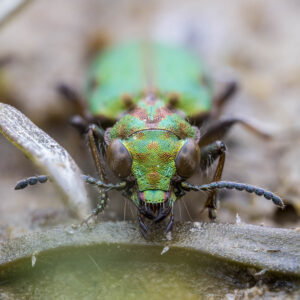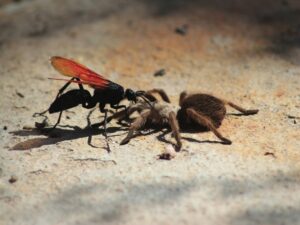Seen from a distance, a vernal pool landscape shimmers with ribbons of color. Rainwater captured in shallow pools evaporates, leaving behind rings of blossoms: sky-blue Downingia, snowy-white meadowfoam, yellow carpet, and goldfields. The short active cycle of a vernal pool ecosystem supports a fleeting riot of life and many specialized relationships, like the one between the endangered Contra Costa goldfield (Lasthenia conjugens) a sunflower relative that depends on vernal pool habitat and its California-endemic solitary bee pollinator (Andrena submoesta).
As the dime-sized Contra Costa goldfields open their faces to the sun, a female Andrena submoesta chews through a dirt gate in her brood cell and bursts into the open air where a male Andrena has been sipping nectar and waiting for her. “This specialized female bee is the most effective pollinator of the Contra Costa goldfield. Their relationship is a marvel of synchronicity,” says Robbin W. Thorp, a UC Davis entomologist.
Small, dark, and often mistaken for flies, most of California’s 1,000 native bee species are solitary bees. Whether they dig burrows or use existing cavities for nests, solitary bees leave provisions for their offspring’s survival—but never have direct contact with the mature bees born of their eggs. The genus Andrena relies on vernal pool flora and fauna, and Andrena submoesta specializes in collecting pollen from goldfields.
Once the female Andrena submoesta has been fertilized, she starts building her nursery during her host flower’s short bloom cycle. She tunnels down through the soil to make a main hall, and then digs side tunnels and brood cells for her offspring. After coating a brood cell with a waxy, waterproof secretion, she flies into the sunny day to collect pollen from the Contra Costa goldfield. She carries large loads of pollen on hind legs equipped with specialized hairs, pollinating the flowers as she goes.
Back in her burrow, she lays a single egg on a pea-size ball of nectar and pollen and then closes the brood cell. Depending on her life span (usually four to six weeks), she may build as many as six burrows—each containing five or six brood cells and lay up to 30 eggs, most likely fertilized during the one mating with a single male. The small number of solitary bee offspring (compared to hive bees and many other insects) makes solitary bees more susceptible to habitat changes. Near Fairfield in Solano County, where 70 percent of the Contra Costa goldfield population occurs, farmland is rapidly being converted to housing.
With new houses springing up faster than the flowers, efforts to protect the native goldfields include a Solano County Water Agency Habitat Conservation Plan calling for the preservation and management of a minimum of 4,400 acres of prime vernal pool habitat. But that may not be enough. “If zones created for the flower’s protection are surrounded by houses, I’m not sure they’ll survive,” says botanist John Vollmar. “To thrive, the goldfields need open space and livestock grazing to keep the European grasses from choking them out.”
The Contra Costa goldfield is a spring annual in the sunflower family. From above, it looks exactly like its cousins, Burke’s goldfield (L. burkei) and Fremont’s goldfield (L. fremontii), but upon closer inspection, the bracts at the base of the flower are fused and the seeds lack a pappus (a parachute-like appendage that helps scatter seed). Its cousins aren’t dependent on a vernal pool ecosystem, whereas the Contra Costa goldfield is. Its diminutive flower head contains as many as 100 individual golden-yellow flowers. Ray flowers that look like petals form the outer ring of the flower head, and the inner flowers are tubular.
Though Andrena submoesta bees specialize in pollinating L. conjugens, other insects also visit the flowers. While investigating Contra Costa goldfields at a vernal pool restoration site at Travis Air Force Base in Fairfield, researcher Jennifer Ramp observed that the “primary visitors of L. conjugens in the restored pools were gnats (Eugnoriste),” and added, “This is the first reported case of an Eugnoriste functioning as a pollinator.” The nectar feeding gnats which are not pollen collectors and thus pollinate only by chance can’t likely replace andrenid bees, but Ramp does hope that they can help pollinate the restored population of L. conjugens until more native bees move in.
In summer, vernal pool habitats may look like dry wastelands, but the cracked mud and brown vegetation hold the next generation of vernal pool life. The Andrena larva rests in its burrow until early autumn, when it transforms into a pupa. By October, it has become an adult bee that remains quiescent throughout winter, awaiting moisture clues that the Contra Costa goldfields are in bloom. (In a drought year, the bees can stay alive and dormant in their burrows until their host flower blooms the following year.) The adult bee emerges when Contra Costa goldfields turn their faces to the light, calling the bee forth with their sweet nectar.
Seeing Contra Costa Goldfields
Though Solano County is home to 70 percent of Contra Costa goldfields, two of the more accessible populations are in Contra Costa and Alameda Counties. On April 15, the Muir Heritage Land Trust is offering a public tour of one of its easement properties off Highway 4 near Hercules. The parcel’s wetland habitat is home to Contra Costa County’s only remaining population of the endangered flowers. Reservations required. Call (925)228-5460 for more information. Contra Costa goldfields also grow around vernal pools at the Warm Springs unit of the Don Edwards National Wildlife Refuge in Fremont. Though the unit is generally closed to the public, there will be several guided vernal pool walks in April. For details, call (510)792-0222, ext. 34.

.jpg)



